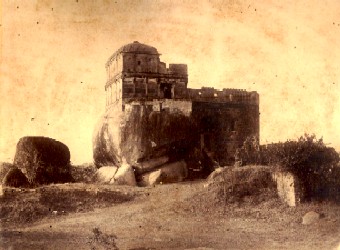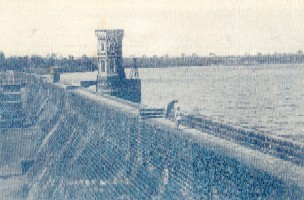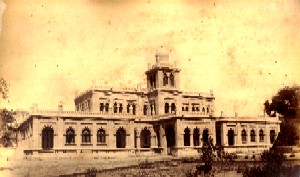 |
|
Madan Mahal Fort of the Gond Dynasty |

Madan
Mahal Fort:
 |
|
Madan Mahal Fort of the Gond Dynasty |
Approximately
five hundred metres above the ground, it still remains a Watch Tower, though
defenders and the attackers have now all passed into history. The fort of Madan
Mahal is situated on the south-western part of the modern city of Jabalpur.
Mystery shrouds over the exact date of this magnificent watchtower. But
the Jabalpur Gazetteer puts it at around 1100 A.D. A strange calmness sets in as
one approaches it through the granite blocks overshadowing the path. After a
five minutes climb, the magnificent monument appears in its historical
exuberance.
This fort was the pleasure palace for Madan Singh, the tenth Gond King
and son of Rani Durgawati. During her reign, the fort was used as a watchtower.
The architecturally designed rooms in front of the main structure probably
lodged the military troops of the rulers who stayed here. The maintenance and
protection of this historical monument has been undertaken by Archaeological
Survey of India.
Nearby stands the Balancing Rock. The amazing characteristic of this
structure is the huge rock balanced on another with just human finger thick
nexus.
Khandari
Water Works:
 |
|
Khandari
Water Works & Bada Fuhara |
Till
the last century, Jabalpur’s water supply was derived entirely from wells. In
the year 1881, an eminently suitable site was selected at Khandari to construct
a reservoir. The purpose as highlighted in the words of Sir J. H. Morris, the
then Chief Commissioner of the Central Provinces, ‘an abundant and never
failing supply of sweet and pure water.’
The project would have been abandoned, as the proposed scheme was too
costly for the Jubbulpore Municipality to undertake unaided, had it not been for
the public service and liberal heart of Raja Gokuldas, who advanced an interest
free loan of Rs. 6,00,000 in the year 1881. The Municipality commenced the
construction in December of the same year, and completed the beautifully built
embankment in record 14-month. The reservoir of Jubbulpore Water-works was
opened on 26 February 1883 by Sir J. H. Morris, Chief Commissioner,Central
Province.
The Water works was the pride of the Central Province. Over the period of
time, Khandari has lived up to its purpose. But today, the city draws only a
part of its water requirement from this reservoir. The famous ‘Phuvvara’
or the fountain situated in the busiest bazar intersection near Lordgunj, was
also built by Raja Gokuldas in the year 1883 to commemorate the completion of
the construction of the Khandari reservoir.
Victoria
Town Hall:
 |
|
Victoria
Town Hall built with |
Presently
known as Gandhi Bhawan Library, inaugurated on September 2, 1892, to commemorate
the Jubilee of Queen Victoria’s reign. The Town hall or Gandhi Bhawan as it
was re-named in the year 1968, came in the wake of crisis. Although it was
constructed to mark the Jubilee year, it was handed over to the public and the
office of the Municipality was shifted to this building, immediately after its
inauguration. Sir A. P. Macdonald, Chief Commissioner of Central Province,
inaugurated this Indo-Saracenic memorial.
It was constructed at the cost of Rs 30,000. The finances were jointly
put in by three who’s-who of the town-Raja Gokuldas, Rai Bahadur Ballabhdas
and Seth Jiwandas. The Municipal offices and library remained in this building
till 1950, when the Jabalpur Corporation was formed and it was shifted
elsewhere.
The library has been popular among the academic scholars for its
availability and accessibility. Gandhi Bhawan, besides the library accommodates
the University study centre and Swatantrata Senani reading cell.
The
Law Courts:
By far, the High Court complex remains one the most beautiful and
imposing edifice in Jabalpur. Henry Irwin of Public Works Department, was the
man behind its designing and construction work. The construction commenced in
1886 and was completed in 1889 at a cost of about Rs. 3 lakhs..
The building originally housed the Collectorate, Law Courts and the
treasury. When the geographical boundaries of new Madhya Pradesh were
crystallised in the year 1956, Jabalpur was chosen as the seat of the High Court
and this building later became the court building with the collector’s office
moving to its new building nearby.
It is interesting to know about the law and order situation of Jubbulpore
in the last century. In the early 1800’s, under Maratha rule, it was standard
practice for the lower-caste widows to be sold, and the purchase money paid into
the State treasury. The tax on sale of property was one-fourth of the price
realised. The British abrogated these laws.
But money lending at usurious rates of interest ranging from 25 % per
annum to 75 % per annum gave rise to most of the litigation. The crime rate of
Jabalpur was second only to that of Nagpur. Prosecution under the Gambling and
Municipal Acts were numerous.